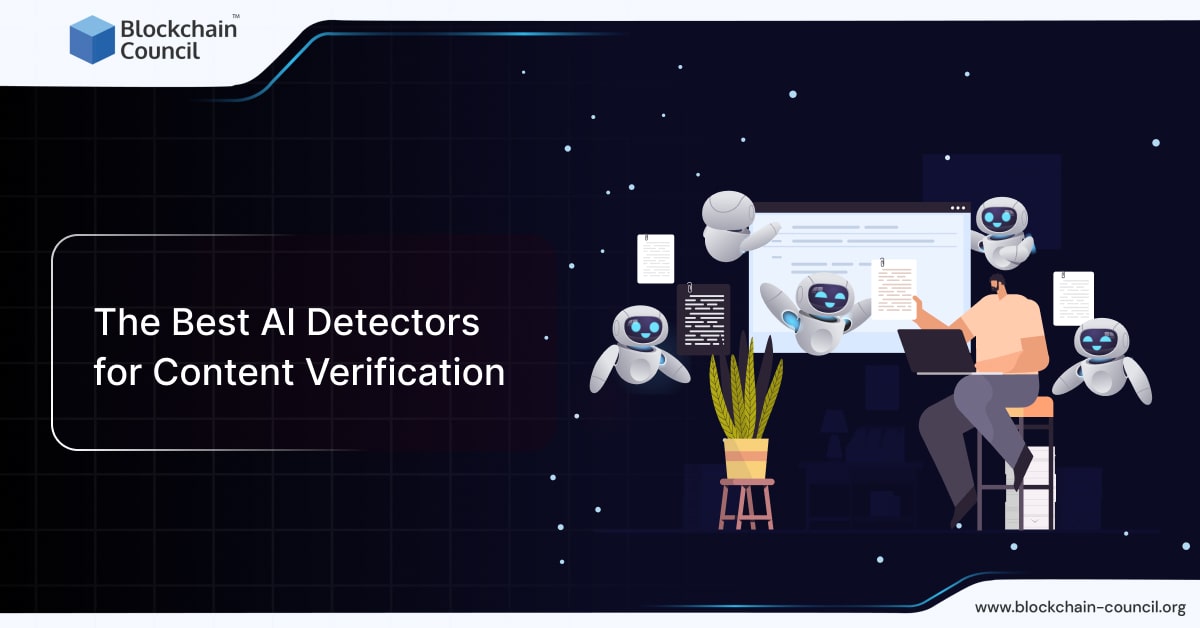
- Blockchain Council
- September 13, 2024
Quick Answer: When looking at AI detectors, you want a platform that can provide diverse language coverage with pinpoint accuracy and effective scalability. Feature-rich platforms with customization options and reporting tools are also important when considering the needs of the user.
What are AI detection tools?
AI detection tools are used to verify whether a piece of content was created by a computer or by a human. AI platforms such as ChatGPT and Bard can generate an ocean of content at an incredible rate. However, this content isn’t necessarily verified or ethical. AI detection tools function in much the same way as the content generation platforms, but instead, they use their vast computing power and databases to detect whether the content was AI-generated. They’re also able to detect plagiarism alongside other useful features.
Why use AI detection tools?
Content created by AI is usually less appealing and natural than that created by a human. Authenticity and integrity can often be compromised by an online content publisher using AI-generated content. This is why BadCredit.co.uk has committed to producing 100% human expert written content for their site.
While content generated by a computer can sometimes be easy to spot with the human eye, it’s still time-consuming and relatively unreliable without the use of AI detection tools. As AI continues to advance, so too do the detection tools, meaning there is essentially an arms race between the two. More and more features are therefore being implemented into detection tools, making them more appealing as time goes on.
How to choose the best detection tool
To find the most effective detection tool, it’s first important to identify what purpose it’s being used for. Is the tool needed for large projects? Should it be looking at one specific AI model or several different ones? These are just some of the questions that need to be asked when picking a detector. Here are some things to look out for when choosing an AI detection tool:
- Diverse Language Coverage – There are many different AI content generation platforms out there, such as ChatGPT, Bard, and Claude. These models have different quirks and ways of being detected. Picking a detector that can cover as many AI platforms as possible is vital to ensure the integrity of the content being published.
- Accuracy – False positives do happen with detection tools. The more accurate the detector, the less likely it’ll be for false flags to appear. It’s also more likely that it’ll be able to pick up the quirks of content created by AI.
- Scaling – The amount of content that needs to be monitored can vary from a single article to potentially thousands of pages. It’s important that the detector can review content at scale without a loss of accuracy.
- Feature-rich – Many detectors offer extra services, such as plagiarism detection and reporting, as well as customization and user preference options. Picking a detector with all these extra features can help tailor the platform to fit the needs of the user as much as possible.
Top AI Detectors
There are numerous different detection tools that can cater to different needs and wants. Some will be better suited for things in the academic realm, while others may be better for sales and reporting.
There are also some that are equipped with more advanced tools that require you to have a paid subscription to access all of the features, so keep this in mind when choosing the AI detector for your business.
Copyleaks
Copyleaks is incredibly accurate and covers dozens of different AI language models. It can detect AI from around 30 different language models at the moment, which gives it way more versatility. The platform has won several business and innovation awards for its work in plagiarism detection.
Copyleaks claims to have a false positive rate of only 0.2%, so that means if you’re working on large-scale projects, you may want to pin this checker to your taskbar. On top of all that, this tool also has a customizable API that can be leveraged to serve different needs depending on the user.
ZeroGPT
Initially designed as a response to ChatGPT, ZeroGPT covers a diverse range of language models. It is a straightforward solution that can be used across various spoken languages worldwide. Teachers and others in the academic world will find this tool super helpful thanks to the attractive versatility of tools and great results.
Although it doesn’t possess the same advanced reporting and scalability features as other detectors, ZeroGPT is freely accessible and does not require a subscription to gain access to all its capabilities. The user-friendly nature of ZeroGPT ensures ease of use, regardless of one’s familiarity with AI.
Winston AI
Winston AI is a powerful detection tool with a lot of additional features. We found that its dashboard enabled us to have a clear overview of the different content being monitored with the option to leverage reporting features as well.
It’s available in English, French, German, and Spanish and claims to have a reporting accuracy of 99.6%. Winston also boasts a high level of scalability and covers a wide range of AI language models, making it another ideal candidate for larger projects.
Conclusion
Choosing the optimal AI detector for you should be based on the specific project requirements. ZeroGPT is great for smaller and more academic-based projects. These projects often don’t need the additional features and tools that platforms like Winston AI have.
Larger-scale and international projects that need extensive oversight and reporting would benefit a lot from platforms like Winston AI or Copyleaks. The cost of subscriptions can easily be justified if you’re doing projects like these. We think that the key to finding the most suitable AI tool lies in identifying your needs and choosing the right tool for the project you’re doing.



































































 Guides
Guides News
News Blockchain
Blockchain Cryptocurrency
& Digital Assets
Cryptocurrency
& Digital Assets Web3
Web3 Metaverse & NFTs
Metaverse & NFTs
